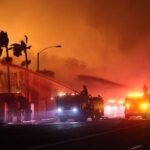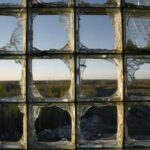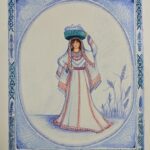Norman Brigade officers and Ukrainian children during a humanitarian aid operation.
Norman Brigade, CC BY-SA 3.0 via Wikimedia Commons
Introduction
Children throughout time have shared the impulse to tell others about their lives. When given the chance, they will draw their feelings, images, and understandings of their world. However inchoate or formed these expressions have been, they nonetheless tell us something valuable about our own humanity.
In this essay, we attempt to hear what they have to tell us when their lives have been upended by war. To do this, we analyze and discuss children’s drawings from the Spanish Civil War and then compare that art to what Ukrainian children are drawing as they suffer through the Russian invasion of their country. We believe that our discussion of these two conflicts raises fundamental questions about adult responsibility for the transgenerational trauma of children during any act of collective violence, past and present.
Why these drawings and not others? The reasons are both thematic and practical. With the brutality of the Russian invasion of Ukraine flooding Western media outlets, there is a unique opportunity to gain a deeper understanding of the impact of war on people’s lives, especially those of children. The Spanish drawings provide an underutilized lens for appreciating what we are witnessing today in Ukraine.
Given our areas of expertise, these two sets of drawings were known to us and accessible. Hundreds of children’s drawings from the Spanish Republic in the 1930s are digitally preserved in several archives in the United States and Spain. Ukrainian children’s drawings are readily accessible on various websites and continue to be produced as we write.
We make no claim that our selection is a representative sample of children’s drawings. After all, children have created art from other brutal conflicts in the modern era. Our engagement with these drawings is not a detached academic exercise. We bring our own experiences to bear in our interpretation of these drawings. In so doing, we invite readers to join in a silent conversation with us. Whether people agree or disagree with what we have to say is less important than readers themselves grappling with what these drawings mean for their own lives today.
Children’s Drawings from the Spanish Civil War
The Spanish Civil War (1936-1939) introduced to the world innovative ways to terrorize and kill civilian populations. The use of unrelenting aerial bombardments and massive artillery shelling of hospitals, schools, marketplaces, and cultural institutions were common features of Franco’s Hitler- and Mussolini-backed military campaign. The goal was to break the will of the people and force the democratically elected government of the Spanish Second Republic into submission. Hitler expanded the use of terror against civilian populations to even greater levels in World War II. The Russian invasion of Ukraine has built upon these legacies. Destruction-wreaked Spanish cities, such as Guernica, Barcelona, and Durango, now have their horrific counterparts in Mariupol, Kharkiv, and Mykolaiv.
Spain had a population of more than twenty-four million people in 1936. By the end of the conflict, nearly one million people had been killed and millions more wounded. Thousands of innocent children were among this toll. More than two hundred thousand were forced to flee their homes in the Republican controlled zones of the country. To safeguard these children from bombardment and shelling, the Republican government evacuated them to sanctuaries along the Mediterranean coast.
These sanctuaries, known as colonias infantilies (children’s colonies), became therapeutic environments for children traumatized by the war. The colonias’ care givers’ approach to play, group activities, and art foreshadowed many of the techniques used today to treat victims of PTSD. These were not ideal educational settings; the colonias had to deal with the deprivation and shortages brought upon by the war. Nonetheless, they provided shelter, food, and a physically and emotionally safe environment in a country consumed by war.
One of the most striking features of the colonias’ daily activities were the thousands of drawings created by its young residents. The children drew from their imagination and their real-life experiences. At times they were prompted by their teachers to draw around a particular theme, such as friendship, loneliness, or patriotism. At other times, they drew what moved them. It is no surprise that many of the more than a thousand drawings that have survived are directly related to their feelings and perceptions of the war.
The following three drawings were chosen among the hundreds we reviewed. Each is unique and yet shares powerful emotions with other children’s drawings from wars in the past and today.
Discussion of Children’s Drawings from the Spanish Civil War
 This shows my town when the airplanes bombed the upper Plaza,
This shows my town when the airplanes bombed the upper Plaza,
and me when I ran for refuge. —Mauricio
This drawing by ten-year-old Mauricio is very typical of many of the children’s drawings from World War II. What stands out as atypical is the arrangement of proportions. For example, the plane is practically the same size as the ambulance. This distorted sense of size might indicate an emotional reality for the child, where he sees the ambulance as a vehicle for saving life and the plane as an instrument of death in this context.
In fact, this drawing depicts one of the many examples of the aerial bombardment done by Franco’s armada of Nazi and Italian fascist planes. So, it is no wonder that the plane is out of proportion. Planes rained death and destruction on numerous villages and cities in Republican controlled Spain.
Another striking detail is the falling tree. The tree, the ambulance’s red cross, the boy, and the smoke trailing from the bomb in the sky are the only objects in color. The green in the tree might represent life, but it is falling and broken, and that suggests it is beginning to die.
Mauricio states in his inscription above the drawing that “I ran for refuge.” There is a faint mark of red on his hands. What is interesting about the use of red is that it is often associated with dead or dying bodies. The body on the stretcher has no arms and legs and is only faintly sketched in pencil. The person might be on their side, which suggests they could be alive, but life seems to be leaving them. In most of the Spanish children’s drawings the dead are without color, such as in this one. The only other place Mauricio uses red in a bold way is on the cross of the ambulance, which again is associated with saving lives.
The emotional impact of this experience on Mauricio can also be seen by how he is running with outstretched arms. It seems the earth is trembling around him. The way Mauricio is running with outstretched arms suggests he wants to grab hold of something. Where is he running? Perhaps he is seeking his mother’s embrace. After all, the world that he knows is coming apart.
In the upper left of the drawing we see what appears to be a fissure in the mountain, as if the very earth is torn apart. There is something about living through a bombing that is particularly horrific. One can only imagine what people are experiencing in Ukraine with the constant Russian shelling of their homes and communities.
 This drawing is the evacuation of my mother and brother when we left for Santander.
This drawing is the evacuation of my mother and brother when we left for Santander.
The cannons shot shells that burned the Arraiz Mountain. —Luisa
In this Spanish drawing by eleven-year-old Luisa, Luisa’s mother is the central figure; she is the biggest person in the drawing. There is no despair in her face. The suitcases they all have in their hands do not seem heavy, as if they left in a hurry or expect to return soon. The children are well put together. Luisa’s family is dressed in the same color.
While Luisa’s mother has a calm and almost serene expression, her children seem stunned. It looks like there might be a procession of other families, because two other children are trailing behind them. We know from the geographic context, as Luisa states in her inscription, that in the background is Mount Arraiz, which is close to Basque Country. That area saw thousands of families fleeing west toward Santander, but also as the war progressed, east to the Pyrenees Mountains and then on to France. People carried what they could, which is evidenced in the foreground where there is discarded extra baggage.
Perhaps the discarded luggage is from another family. That could be a sign that the family died. The family we do see might have stopped to gaze at the horror in front of them. However, there is still a road ahead of them where they can continue their journey. We know from survivor accounts and photographic evidence that thousands of refugee families fled for safety along these country roads.
This scene is reminiscent of when Leningrad was under siege for almost nine hundred days during World War II. There was one road used for the evacuation of children on frozen Lake Ladoga. That road was called “The Road of Life.”
It is interesting to note that in the Spanish drawings pertaining to the war, girls focus more on the evacuation of families. The boys focus on bombing and combat by about a three to one ratio. That’s not always the case, but overall the girls tend to draw more detail on the ways human life has been affected by the war. The boys depict more instruments of destruction, such as planes and bombs.
These gendered differences can be seen in many of the current day Ukrainian drawings of war. The boys focus on tanks and planes, while more girls draw nature scenes or people praying for Ukraine’s future.
The next Spanish drawing, Consequences of the War, has a prayer scene depicted by a thirteen-year-old girl named Concepción. In the body of the drawing are the words, “Death of a hero and pain of my mother.”
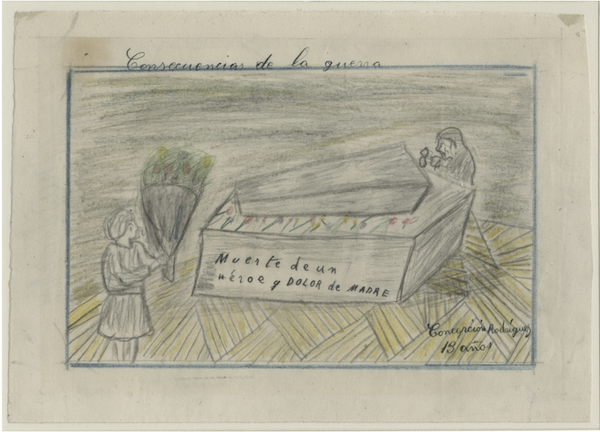 Consequences of the War
Consequences of the War
Depression and hope seem to be conveyed in this drawing. Hope is signified by the yellow floor and the bouquet of flowers. The girl is probably Concepción, and the woman is likely her mother. The main image appears to be a table with a coffin on it. The size of the table is drawn out of proportion to the other elements, perhaps a sign of despair. The body language of the mother figure suggests she is silently praying. The flowers on the table could indicate many people have come to say farewell to the “hero.”
Both mother and daughter are all drawn in black without any touch of color because they are in mourning. The yellow in the floor is a striking contrast to the black in the drawing. The floor tells the viewer that there is hope and life. Death is not completely victorious. Concepción’s mother seems to be shrinking in size next to the coffin and table, but Concepción is much bigger, and so are her flowers, which is life affirming.
One could have a very different take on what is going on here. It might not be a table but rather a box full of bodies. What passes as a parquet floor is really rotting wheat on the ground. As in Ukraine today, the fascist forces during the Spanish Civil War destroyed food sources in Republican held territory. It does seem Concepción’s mother is in mourning, and Concepción has flowers to honor the dead, but it is within the context of a desiccated and shriveled countryside.
In either case, unlike in the other drawings, we see the assertion of a patriotic theme in the mourning of a dead hero. However, there are no crucifixes or churches in the drawing, which is striking for a time when the Catholic Church dominated social life. This might speak to the fact that the Republic did its utmost to limit the power of the Church and promote a secular society. The children in the colonias infantiles were inculcated with this secular ideology, but that doesn’t mean these Spanish drawings should be dismissed as propaganda. Real hope, grief, and a range of very raw and powerful emotions are expressed in what these children drew.
There also might be anger here. While the mother appears to be praying, her hands could be clenched fists and the wide-open mouth indicates she is shouting. She doesn’t want to just accept the fate of her son. When there is a hero, there is also respect, respect for the family and for all those who have been killed. Like her mother, Concepción is grief stricken, but in her erect stance, she exhibits a spirit of resistance.
Children’s Drawings from the Russian Invasion of Ukraine
February 24, 2022, marked the day when Putin’s military forces invaded Ukraine and changed the lives of forty-one million Ukrainians, the sociopolitical situation in Europe, and attitudes toward Russia and Russians throughout much of the world. Since then, Western, Ukrainian, and exiled Russian journalists have reported on the terror and destruction brought upon innocent civilians.
Among those civilians who have suffered the most are children. The office of Ukraine’s prosecutor general estimated in November 2022 that over 437 children had been killed and over 810 wounded, though it was widely acknowledged that these numbers were probably much higher then and have certainly grown as the war grinds on.
Currently, there are many humanitarian organizations and websites which collect children’s drawings, exhibit them, and sometimes sell them online to raise funds for Ukraine. Some of this art is very sophisticated, and some is less developed. Regardless of its artistic value, all the drawings we have examined reveal a range of powerful emotional responses to the horrors of war. The following three Ukrainian drawings reflect the children’s experiences.
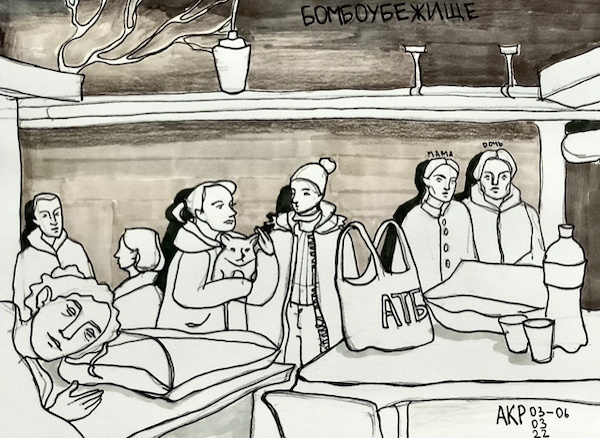 My Bomb Shelter
My Bomb Shelter
Underneath this Ukrainian drawing, titled My Bomb Shelter, thirteen-year-old Anna from Kharkiv wrote, “When the Russian missile hit my house, my parents and I immediately ran to the nearest bomb shelter. Surprisingly for me, strangers who saw me for the first time wanted to help me so much. We were immediately shown where we could stay, be fed, and be safe. Even though there were no conditions, there were wonderful people who made this dull place better.”
What Anna wrote comes alive in interesting ways in her drawing. The people in this bomb shelter appear in outline form. Their bodies are white, and the outline is in black pencil, while the ceiling and walls are in light and dark gray. This technique creates the feeling that these people experience a shadowy kind of existence. At the same time, judging by the way the faces are drawn, there is a sense of determination and grim fortitude. A couple of people appear to smile.
The dimensions of space in this drawing are also striking. If these people stand up, they will need to bend their heads because the ceiling is so low, yet the bottle on the table is almost the same size of the people. This water or milk bottle is emblematic of having food and drinks, which means life is sustainable in the shelter. The people seem comfortable with each other. The person lying down is very calm and even smiling in their sleep. There is a woman holding and petting a cat.
It also looks like other people are talking in very quiet voices, as if not wanting to disturb the person sleeping. The person feels safe enough to sleep surrounded by complete strangers, not fearing robbery or injury. It goes back to that sense of community and even solidarity among strangers crowded into a makeshift bomb shelter in a subway.
In Ukraine, people are used to sitting with strangers in the many long-distance trains that span the countryside. Passengers usually spend time in conversation, while sharing food and stories. However, there is at least one critical difference between bomb shelters and trains. In this drawing, people are united not just by a common space and the need to spend time together but also to protect their own lives and the lives of their loved ones. That creates an even stronger sense of community, heightened by the Russian invasion of their country.
In a way, this drawing is a metaphor for a nation under siege, a nation where people sacrifice and share a situation that has been going on not just for days or weeks, but for months. So, they know what it takes. Community is in the air, both above and below ground.
People living through the Spanish Civil War did not have access to the same kind of elaborate system of bomb shelters that Ukrainians have today in their cities. In the Spanish Civil War, aerial bombardment by Nazi and Italian planes was new and terrifying. During World War I, there were aerial dogfights, but they did not inflict mass bombings that destroyed houses and killed civilians. That was an innovation by Franco’s military alliance with Nazi Germany.
The Nazi role in the bombings of Republican Spain has its own parallel in the Nazi occupation of Ukraine during World War II. There is hardly a single Ukrainian family who does not have grandparents who were wounded or killed during that war. The scars of these losses are still in their collective memories. For those who are young, such as Anna, it is history that they have studied at school and now are experiencing in real life with the Russian invasion.

This untitled Ukrainian drawing is by thirteen-year-old Angelina from Dnipro. Her city has been heavily shelled, and most of its population has been evacuated.
The hand is such a central image in the drawing. It’s probably a mother’s hand, waving a farewell to the two children on the train. The children are likely siblings, a teenage girl and her little brother. The girl’s hand appears on the boy’s shoulder, signifying she is going to take care of him.
The large hand conveys a protective force for the family. The children are leaving this protection behind and are headed into the unknown. The window itself is an interesting image. While it is a regular train window, it also is a window into the unknown. The two siblings don’t know what to expect in the future.
Along with the importance of the hand on the window is Angelina’s use of color. The colors of blue and yellow are dominant, which are the colors of the Ukrainian flag.
Children during the Spanish Civil War did not have the same access to crayons and colored pencils because supplies were very limited. The coloring pencils they did have would have been supplied by the International Red Cross or the American Friends’ Service Committee. The famous Spanish propaganda posters of that era were much more colorful, but those were usually done by professional artists working for the Spanish Republican government.
Another contrast with the Spanish drawings can be seen in the profiles of the people on the train sitting behind the two children. They are not bedraggled; their clothes are not ripped up or torn. These people seem more prepared for their journey than in so many of the Spanish drawings. They are not starving; they are not wandering on the road as in Luisa’s Spanish drawing. Here, it looks more like an organized exodus, and these children, although saying goodbye, are not lost. They are being taken to a safer place in a modern train.
Even the cat in the travel case suggests a baseline of safety and preparation for the trip. This family had enough of a chance to prepare for their journey. They may take pride in maintaining a sense of dignity during such a terrible time in their country. It suggests that there is enough of a sense of intactness that they can do it. It’s not like they are going to the GULAG, or they are going to Treblinka. At least in this case, they are going to safety. Nonetheless, they leave behind their loved ones with the hope they will be reunited one day.
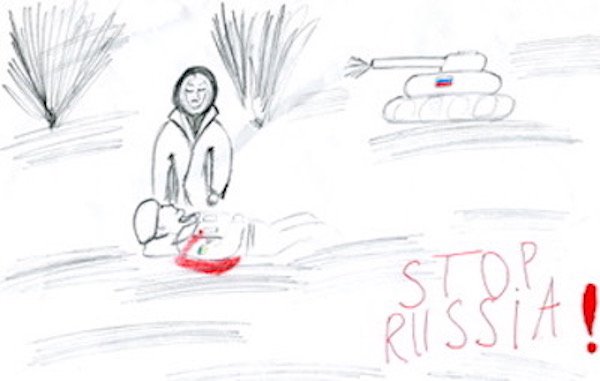
The final untitled drawing is by eleven-year-old Elizaveta from Kyiv. She is a student in a secondary school that emphasizes an in-depth study of English.
The woman is the prominent figure here. Her face is not just mournful when she looks down at the fallen soldier, who could be her son. There is anger and determination in the woman’s face. The lip curled down suggests a kind of stubborn determination. The curved line of the woman’s mouth does not create a sense of agony but rather of grace. The background shows that shelling is ongoing. Bombs are falling, and the Russian tank is still present.
This woman seems to represent a readiness to protect her son even when he is dead. The patch of yellow and blue colors on his uniform speak to the sacrifice made for Ukraine. Both figures are metaphorical. She is a symbol of all mothers grieving the deaths of their children but also a figure of strength. The soldier represents young people dying for their country’s independence. The mother might be ready to get up from her knees and start moving toward the slogan, “Stop Russia!” The words themselves, written in red with the bold exclamation mark, look as if they are coming out of her mouth, as if a call to all mothers to stop the war.
Elizaveta’s drawing is saturated throughout with symbolism. In this respect, it is very similar to Concepción’s drawing of a woman standing next to a coffin with clenched fists. Both drawings exhibit patriotism and defiance against an oppressor.
In contrast to Concepción’s Spanish drawing, we see a tank, which is a symbol of the ongoing attacks on civilians. So, the son might have been one of many who tried to defend their land but fell in battle.
The woman acts as a barrier between the explosions in the background and her son’s body. There is a blank white space, and the positionality of these figures, the explosions, and the “Stop Russia!” slogan in this blank space are very powerful images. There is not a lot of color, but what color there is gets heightened with the white background. This 11-year-old girl did it so well using very simple tools.
The “Stop Russia!” in red also evokes the stain of the Russian occupation, but there is determination by the mother in this drawing. We see that both in the drawing by Luisa from Spain and now in Elizaveta’s drawing. Viewing them together, one is left with a greater appreciation of the strength of the Ukrainian and Spanish women in the face of collective violence all around them.
There is this combination of sadness and strength represented in the figures of the women in both drawings. In Elizaveta’s drawing, there are traces of tears coming from the woman’s closed eyes. Other than that, she appears calm and quiet. Her figure represents grace and dignity. The decision to portray the woman with her eyes closed is a powerful strategy, possibly demonstrating that she can’t bear seeing her son dead.
That said, the strokes used to depict shadows are very rough and harsh. This harshness is in strong contrast to the tranquility of the woman’s figure. Harshness also creates the feeling of the existing danger symbolized by the tank. However, the figure of the woman is much larger in size than the tank, which creates the feeling of hope that Ukrainian mothers will stand up and oppose the aggressor.
Reflections
The artistic voices of these children sear one’s conscience. This type of art is a testimony that screams at us, that travels through time and demands us to think about and act on our responsibility to the innocent.
In their own way, these drawings are visual accusations of war crimes. The UN’s Convention on the Rights of the Child has over fifty articles that cover major rights for children. These drawings serve as a testimony to what rights children have been deprived of in war. What we don’t see in these drawings is children playing games. Through play and games, children experience the world. That’s how they grow and develop. The child educator and advocate, Janusz Korczak, once wrote, “When participating in a game, the child feels to some degree independent. Everything else is a transient favor, a temporary concession, whereas to play is the child’s right” (How to Love a Child).
As educators and parents, we know the fundamental importance of play for children’s development. Korczak used theatrical plays for children in his orphanage in the Warsaw Ghetto. The last one was staged a couple of weeks before they were deported to Treblinka.
When we step back and reflect about both these select Spanish and Ukrainian drawings, we confront the utter destructiveness of war on children’s lives. Yet, within that context, something else comes to mind: how resilience can be nurtured in children who experience this kind of trauma. In Spain, you had the colonias infantiles, which allowed the children to play and draw about their experiences. These children’s colonies were incubators of love. The point is not to romanticize those places. They weren’t perfect. But by and large they were staffed by adults who cared about the children. The children were safe from the bombing and gunfire ravaging the rest of the country. In the Ukrainian situation, refugee centers have become places where kids can draw and feel safe.
For the Spanish and Ukrainian children who made these drawings, drawing was a way to throw out negative emotions into the world and a way to cleanse their own minds and souls. When they shared these drawings with others, it became a way to liberate themselves from negativity.
When therapists work with children who have been abused, they often have them draw their thoughts and feelings. We know how important this can be in the healing process. The same applies to the trauma of war, especially for children.
What about all the children in Spain, Ukraine, and other areas of conflict who have not had these protected spaces where they could draw and play? It is hard to imagine what it must be like for all the Ukrainian children who have had to huddle in basements or subway shelters while bombs explode in the city or village that was once was their home. To live in constant fear is hard for adults, but it is daunting for a child. It is like a double crime being committed against them.
That is why more people need to be aware of these artistic voices when they are available to us. There are drawings from Rwanda, Bosnia, Syria, and numerous other conflict zones, past and present. We know that some of these children, when they could, drew about their experiences of war. More people need to see these. We need to look at this art and talk about it. We can’t lose those artistic voices. Once you confront them, you are changed.
Today, Ukrainian groups are collecting drawings from children. There have been more than thirteen thousand collected by just one NGO, and there are several of them. There is a feeling that these drawings are part of the evidence of what has happened in their country. It is a type of ethical evidence for us today and for future generations.
In a post-Nuremberg world, there needs to be a category of crimes against children, not just killing children but also kidnapping them, indoctrinating them, instilling perpetual fear in them, as we have seen in what Putin’s regime has done. Those experiences will scar children for the rest of their lives. Some of these children will become suicidal or violent themselves. The children who have experienced the Russian brutal wars in Chechnya and Syria—what has become of them now?
What do we do after we have seen these drawings? Perhaps, a first small step is to open this discussion to others. If more people discuss what these drawings mean, then that leads to action. Maybe each act, such as donating to a nonprofit group doing refugee work or tutoring refugees in one’s community, is different for each person. On a larger scale, though, how does our society and the international community work to prevent these horrible wars that destroy the lives of children?
We also need to hear the actual voices of children. When we talk about children’s rights, we need children talking about their own rights. For example, in Kharkiv, there was a teacher who gave art lessons to children hiding in a subway. They began drawing on the walls inside other Metro stations. The drawings became a vital outlet to visually express what they were feeling and thinking. Their work spurred discussions among both adults and children who walked by the art.
This kind of art should be part of children’s education across the world. It could be a very important element for developing compassion and kindness in other children. These individual drawings make the experience of war personal and intimate.
It’s not just about numbers and showing piled bodies to make people feel guilty. This is about humanizing people. One must be thoughtful about using this material. What do we show? How do we talk about it?
If such drawings could be included in a curriculum, they would provide an opportunity to talk about the symbolism that is part of the children’s art. These drawings are not just about individual families and their experiences. So many of these children had their childhoods stolen. To have lived in fear, been forced to hide, separated from one’s family, and even kidnapped is a reality for countless children around the world today. When they draw about those experiences, in whatever form they take, they leave a painful gift for the rest of us. We must think long and hard about what do we do with what they have left us.

Sources for Children’s Drawings
Spanish Drawings
The three drawings from the Spanish Civil War were obtained from the library open-source digital archive of the University of California San Diego’s (UCSD) Mandeville Special Collections.
Ukrainian Drawings
The three Ukrainian drawings were obtained from several public websites. They are available for viewing and/or purchase on the following websites.
-Anna’s My Bomb Shelter Drawing is found at Teens Save Ukraine.
–Angelina’s Drawing is found on the Mom I See War Project website.
-Elizaveta’s drawing is found at Wars in the Eyes of Children.



